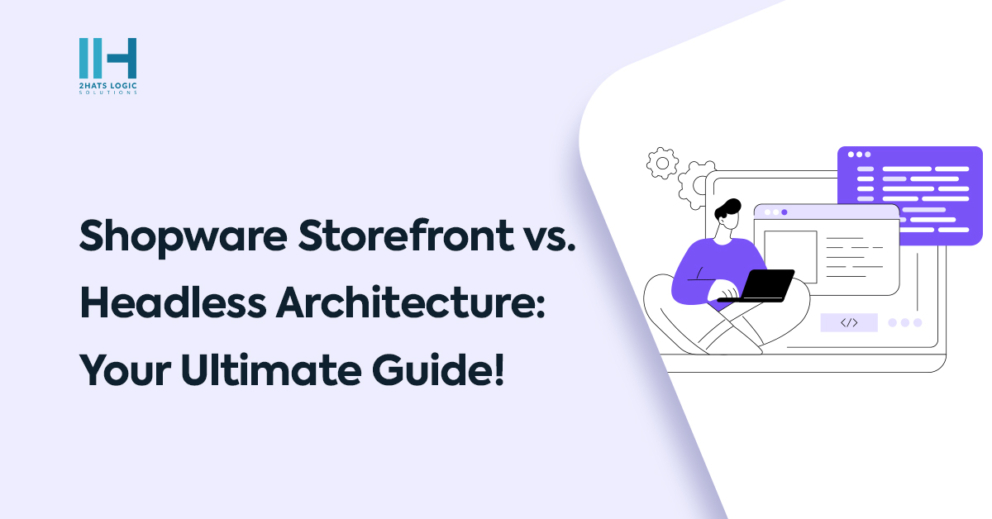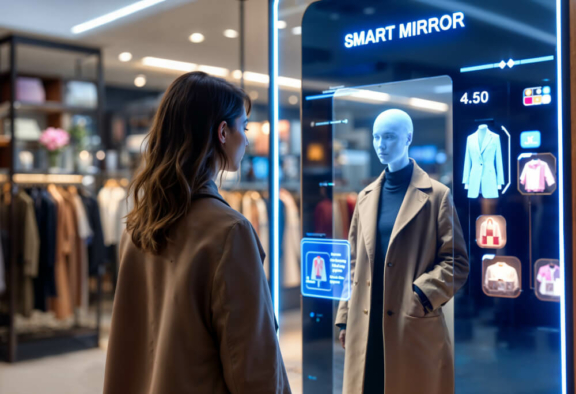Greetings! I'm Aneesh Sreedharan, CEO of 2Hats Logic Solutions. At 2Hats Logic Solutions, we are dedicated to providing technical expertise and resolving your concerns in the world of technology. Our blog page serves as a resource where we share insights and experiences, offering valuable perspectives on your queries.

Choosing the right setup for your online store is super important. It’s like picking the foundation that decides how well your business can grow, stay safe, and make customers happy in the online world. This setup is the backbone, shaping how your digital store looks and making sure everything runs smoothly.
If you’ve decided to go with Shopware for your online shop, the next big question is: Do you want the regular Shopware store look, or do you prefer a more flexible setup called headless architecture? This blog is here to help you figure out which one suits your business needs better.
What is Monolithic Architecture in Shopware Storefront?
Shopware follows a traditional monolithic architecture, where the entire application is built as a single, unified unit. In this context, the different components of the e-commerce platform, such as the storefront, admin interface, and database, are tightly integrated into a singular software stack. While monolithic architectures are known for their simplicity, they can face challenges in terms of scalability and flexibility as the application grows.
Advantages of Shopware Storefront
Cost-Effective
The development and operational costs associated with a monolithic architecture can be lower compared to more distributed systems. A single codebase, unified technology stack, and simplified infrastructure contribute to cost-effectiveness, especially for smaller and medium-sized businesses.
Ease of Development
Monolithic architectures are known for their simplicity. In Shopware, having a single, unified codebase makes it easier for developers to understand, build, and maintain the application. This simplicity can lead to faster development cycles and quicker time-to-market for new features.
Unified Technology Stack
Shopware’s monolithic architecture means that all components, including the storefront, admin interface, and database, use the same technology stack. This simplifies technology choices and reduces the complexity associated with managing diverse technologies across different components.
Efficient Communication Between Components
With all components tightly integrated within the monolith, communication between different parts of the system is more efficient. This can lead to faster data retrieval and processing, enhancing the overall performance of the e-commerce platform.
Easier Debugging and Troubleshooting
Debugging and troubleshooting are more straightforward in a monolithic architecture. Developers can trace issues through the entire application stack within a single codebase, making it easier to identify and resolve problems compared to more distributed architectures.
What is Headless Architecture?
Headless commerce is an e-commerce architecture where the front end (the “head”) and the back end (the “body”) of the system are decoupled or separated, allowing for greater flexibility and customization.
Benefits of Headless Architecture
Flexibility and Agility
Headless commerce provides flexibility and agility by decoupling the front end and back end. This makes it easier for businesses to customize the front end independently and to rapidly adapt to market changes.
Innovative Customer Experience
Storeowners can adopt emerging technologies, such as augmented reality or voice interfaces, to create immersive and innovative shopping journeys. The flexibility to experiment with design and technology fosters a unique and engaging experience and enhances customer satisfaction.
Multi-Channel Consistency
Headless architecture allows businesses to maintain a consistent brand experience across multiple channels and devices. With the front end decoupled, content can be easily adapted and delivered to various platforms, ensuring a smooth experience for customers whether they’re accessing the e-commerce site via a website, mobile app, or other channels.
Quick Adaptation to Market Trends
Businesses can swiftly integrate new features, design changes, or technology advancements without disrupting the entire system. This agility enables merchants to stay ahead of competitors and meet customer expectations in a dynamic and ever-changing marketplace.
Efficient Content Management
Headless commerce lets businesses use specialized tools for content management, freeing you from relying on developers for every change. This translates to faster updates, targeted campaigns, and dynamic content – all without breaking the e-commerce engine.
Factors for decision-making
Scalability
Shopware Storefront
Analyzing Shopware Storefront’s scalability involves assessing its ability to handle increased product catalogues, user traffic, and transaction volumes. Shopware’s monolithic architecture allows for vertical scaling, where resources can be added to the existing server to manage growth.
Headless Architecture
Headless architecture excels in scalability by enabling independent scaling of front-end and back-end components. This approach offers horizontal scaling, allowing businesses to distribute load across multiple instances, ensuring efficient handling of growing demands.
Considerations for handling growth and expansion should include evaluating the anticipated scale of the business, resource requirements, and the potential need for horizontal scaling to accommodate increased workloads.
Flexibility and Customization
Shopware Storefront
Shopware Storefront provides a level of customization within the confines of its monolithic structure. Businesses can customize the storefront’s appearance, but the extent may be limited compared to headless architectures.
Headless Architecture
Headless architecture excels in flexibility and customization. The decoupling of the front end and back end allows businesses to choose and customize technologies independently. This flexibility is advantageous for tailoring user experiences, incorporating new technologies, and adapting rapidly to changing business requirements.
Time-to-Market
Shopware Storefront
Shopware Storefront’s monolithic architecture may present challenges in terms of time-to-market for new features. Updates to both the front end and back end are typically made together, potentially slowing down the deployment process.
Headless Architecture
Headless architecture accelerates time-to-market due to the ability to independently develop and deploy front-end and back-end updates. This separation allows for quicker iterations, faster development cycles, and more agile responses to market demands.
User Experience
Shopware Storefront
Shopware Storefront provides a standardized user experience within its monolithic structure. While it offers a cohesive interface, the level of customization might be limited compared to headless solutions.
Headless Architecture
Headless architecture excels in creating innovative and tailored user experiences. Businesses can adopt emerging technologies and experiment with designs, fostering a unique and engaging journey for customers across various channels.
Final Considerations
Choosing between Shopware Storefront and Headless Architecture depends on what your project needs. If you want something easy to use and quick to set up, go for Shopware Storefront. It’s good for most businesses. But if you have a big project and want it super customized and flexible, Headless Architecture is better.
Think about what’s most important for your project, what you can do with development, and what you want in the long run. That way, you can pick the one that fits your e-commerce plans the best. And remember, discussing it with Shopware developers can provide valuable insights tailored to your specific situation.
FAQ
What is the primary difference between Shopware Storefront and Headless Architecture?
Shopware Storefront follows a traditional monolithic architecture, where the entire application is built as a single, unified unit. On the other hand, Headless Architecture decouples the front end and back end, providing greater flexibility and customization options.
How does scalability differ between Shopware Storefront and Headless Architecture?
Shopware Storefront allows for vertical scaling within its monolithic structure. In contrast, Headless Architecture excels in scalability by enabling independent scaling of front-end and back-end components, offering horizontal scaling to efficiently handle increased workloads.
Which option is more suitable for businesses looking for quick adaptability to market trends and changes?
Headless Architecture is better suited for businesses aiming for quick adaptation to market trends. Its decoupled structure allows for independent development and deployment of front-end and back-end updates, leading to faster iterations and more agile responses to market demands.
How does the user experience differ between Shopware Storefront and Headless Architecture?
Shopware Storefront provides a standardized user experience within its monolithic structure, while Headless Architecture excels in creating innovative and tailored user experiences. The latter allows businesses to adopt emerging technologies and experiment with designs, providing a unique and engaging journey for customers across various channels.
What factors should businesses consider when deciding between Shopware Storefront and Headless Architecture?
Businesses should consider factors such as scalability, flexibility, time-to-market, and user experience. Shopware Storefront is suitable for those seeking simplicity and ease of use, while Headless Architecture is preferable for projects requiring high customization, flexibility, and quick adaptation to market changes. It's crucial to align the choice with the specific needs and goals of the e-commerce project.

Related Articles





